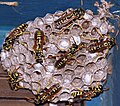Wasp
Wasp is a term used to describe a diverse group of insects in the order Hymenoptera. They are known for their distinctive appearance, which often includes bright colors and a narrow waist, and their ability to sting. Wasps can be found all over the world and play a crucial role in ecosystems as predators, pollinators, and parasitoids.
Classification and diversity[edit]
Wasps belong to the order Hymenoptera, which also includes ants and bees. There are over 30,000 known species of wasps, which are divided into two main groups: the Apoideans, which include bees and wasps that are bee-like in appearance, and the Vespoids, which include the more typical wasps.
Anatomy and appearance[edit]
Wasps have a distinctive appearance that includes a narrow waist (or "petiole") that separates the thorax from the abdomen. They also have two pairs of wings, with the larger forewings covering the smaller hind wings when at rest. Wasps are often brightly colored, with many species having yellow and black markings.
Behavior and ecology[edit]
Wasps play a crucial role in ecosystems as predators, pollinators, and parasitoids. Many species are solitary, but there are also many species that are social and live in colonies. Some wasps are known for their aggressive behavior when threatened.
Human interaction[edit]
While wasps are often viewed as pests due to their ability to sting, they are also beneficial to humans in many ways. They help control pest insect populations, and some species are used in agriculture for biological pest control. Some wasps are also pollinators, helping to pollinate crops and other plants.
See also[edit]
References[edit]
<references />
|
|
|
-
Vespula germanica
-
Wasps are Paraphyletic
-
Neotype male of Electrostephanus petiolatus in Baltic amber
-
Indian yellow wasp
-
Megascolia procer
-
Ichneumon wasp (Megarhyssa macrurus lunato)
-
Wasp with Orange-kneed tarantula
-
Active Wasp Nest
-
Potter Wasp building mud nest near completion
-
Vespa crabro
-
Wasp August 2007
-
Indian Spider Wasp
Ad. Transform your life with W8MD's Budget GLP-1 injections from $75


W8MD offers a medical weight loss program to lose weight in Philadelphia. Our physician-supervised medical weight loss provides:
- Weight loss injections in NYC (generic and brand names):
- Zepbound / Mounjaro, Wegovy / Ozempic, Saxenda
- Most insurances accepted or discounted self-pay rates. We will obtain insurance prior authorizations if needed.
- Generic GLP1 weight loss injections from $75 for the starting dose.
- Also offer prescription weight loss medications including Phentermine, Qsymia, Diethylpropion, Contrave etc.
NYC weight loss doctor appointmentsNYC weight loss doctor appointments
Start your NYC weight loss journey today at our NYC medical weight loss and Philadelphia medical weight loss clinics.
- Call 718-946-5500 to lose weight in NYC or for medical weight loss in Philadelphia 215-676-2334.
- Tags:NYC medical weight loss, Philadelphia lose weight Zepbound NYC, Budget GLP1 weight loss injections, Wegovy Philadelphia, Wegovy NYC, Philadelphia medical weight loss, Brookly weight loss and Wegovy NYC
|
WikiMD's Wellness Encyclopedia |
| Let Food Be Thy Medicine Medicine Thy Food - Hippocrates |
Medical Disclaimer: WikiMD is not a substitute for professional medical advice. The information on WikiMD is provided as an information resource only, may be incorrect, outdated or misleading, and is not to be used or relied on for any diagnostic or treatment purposes. Please consult your health care provider before making any healthcare decisions or for guidance about a specific medical condition. WikiMD expressly disclaims responsibility, and shall have no liability, for any damages, loss, injury, or liability whatsoever suffered as a result of your reliance on the information contained in this site. By visiting this site you agree to the foregoing terms and conditions, which may from time to time be changed or supplemented by WikiMD. If you do not agree to the foregoing terms and conditions, you should not enter or use this site. See full disclaimer.
Credits:Most images are courtesy of Wikimedia commons, and templates, categories Wikipedia, licensed under CC BY SA or similar.
Translate this page: - East Asian
中文,
日本,
한국어,
South Asian
हिन्दी,
தமிழ்,
తెలుగు,
Urdu,
ಕನ್ನಡ,
Southeast Asian
Indonesian,
Vietnamese,
Thai,
မြန်မာဘာသာ,
বাংলা
European
español,
Deutsch,
français,
Greek,
português do Brasil,
polski,
română,
русский,
Nederlands,
norsk,
svenska,
suomi,
Italian
Middle Eastern & African
عربى,
Turkish,
Persian,
Hebrew,
Afrikaans,
isiZulu,
Kiswahili,
Other
Bulgarian,
Hungarian,
Czech,
Swedish,
മലയാളം,
मराठी,
ਪੰਜਾਬੀ,
ગુજરાતી,
Portuguese,
Ukrainian














